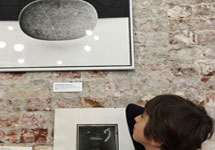звоните: +7 495 204-207-8
e-mail: art@quartagallery.ru
Recent posts
- Необычная судьба тверской художницы Наталии Пономаревой
- Жемчужина деревянной архитектуры русского севера
- Первая народная галерея в Льялово
- Online auction - a practical instruction. How to take part?
- История русской анимации и коллекционирование «истории» мультипликационных фильмов
- История в гравюрах и литографиях уникального печатного издания «Революционная Москва: Третьему конгрессу Коммунистического Интернационала». 1921
- Painting as a Gift
- What happened to frescoes of Kievskaya Metro Station?
Art and Children: what do the scientists say?

When we go to museum we don’t really think “why?”. This is our inner unconscious desire: for someone the emotional part is more important, someone wants to receive aesthetic pleasure, while others expand the boundaries of the world outlook and its perception. But adults don’t think before they buy tickets to this or that exhibition – they just do and it seems that their desire to be closer to “something beautiful” was inherent in them from the very beginning.
Everyone knows that many of the necessary skills are laid down from childhood, it is not a secret. When you are a child it’s easier to learn how to bike, to remember the dance band or to express yourself on the piece of paper. The perception of the entire world is completely different: pure, the child is open to anything new without extra fears.
When we go with a child to museum we start to think: what if it’s boring or maybe he or she is too young for it? Is it worth it to have an excursion? Despite the obvious reasons why it is still worthwhile to instill in the child a love towards art, such as cultural education and aesthetic development, there is also a scientific approach. Just drop all doubts and buy ticket, as the scientists have already answered the main question: what is the benefit?
First of all, it develops spatial-visual thinking – the ability to picture images and objects in the head and "work" with them. Do not forget that development of knowledge should occur not only through texts and numbers, but also through visual perception, thereby children learn how to interpret, analyze and use visual information to make a choice based on it later on. Due to this reason it is significant not to restrict children’s aspiration to painting/modeling and other self-expression forms and not to lead them to academic degree since childhood, without fantasy limits. It will help to develop as it is more comfortable for them.
One more benefit is skill of focusing. It happens quiet often that children are full of energy and due to this it’s harder to concentrate for them, especially if they are not interested in it – they wont waste time on it. Therefore, it is very easy to distinguish a good children's guide in the museum: a good one has a special talent to lead children to this world of art so that they can look at the painting or sculpture for a long time, they are fascinated by what is happening, the imagination in their heads draws the entire universes. On one hand, at this moment the right part of the brain is very active, developing creative thinking, but at the same time there is a perception of the narrator's words that connects to the left hemisphere, thereby immersing the child in the unity of feelings and thoughts, revealing his infinite creative potential.
Furthermore, there were neurophysiological studies: how artworks influence on people. One of this study determined that when we look at the painting (scientists used Monet, Botticelli and Leonardo da Vinci works), then the areas in brain that are associated with love are activated, causing a surge of dopamine so we feel happy and comfortable. It helps to develop children’s sensitive perception, express emotions in different ways and solve some behavior problems if there are such issues.
With the right presentation, after the exhibition or excursion, children ask a lot of questions related to one work or to what they saw in general, thus they form a research skill, there is a desire for knowledge, through art a whole system of views and thinking skills is transmitted to them, which in further they could apply in various spheres of life.
It should be noted that one should not take this too seriously, but rather turn it into a game that would take up both adults and children. After all, art is about freedom and beauty, it is like an inexhaustible source, created so that we can experience something completely unknown to us earlier, plunge into a new world and draw inspiration.
